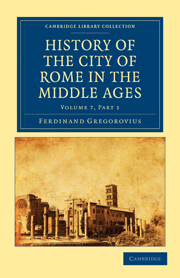CHAPTER I
Published online by Cambridge University Press: 01 March 2011
Summary
The downfall of the political independence of the Roman commune at the time of Martin's return from Constance closed the true Middle Age of the city. We might therefore look on our task as ended, were it not that the universal character of Rome demands the continuation of her history through the period of transition that followed down to the time when the Roman ecclesiastical ideal of the Middle Ages was shattered by the German Reformation.
During these hundred years was accomplished the great transformation of Europe, which is called the Renascence. On one side only was it a revival of antiquity; speaking generally it was the entire reform of Western culture.
In the Latin world it appeared as the renascence of classic paganism. In the German it became the renascence of evangelical Christianity. And to the combined working of these two divisions of the European intellect modern culture owes its rise.
The accomplishment of the noblest ideals of man in ecclesiastical and civil affairs, in the life of nations, and in that of individuals, must necessarily be the work of centuries: nevertheless, as early as the fifteenth century, it is visible as the budding germ of a new ideal of culture, which took the place of the catholic ideal of the Middle Ages, such as had hitherto been expressed in the Church and the Empire—the universal forms of the West.
- Type
- Chapter
- Information
- History of the City of Rome in the Middle Ages , pp. 1 - 100Publisher: Cambridge University PressPrint publication year: 2010First published in: 1900



